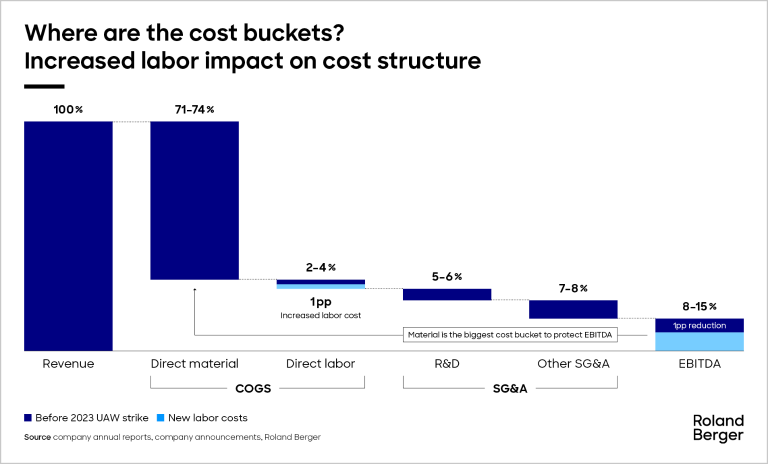AI is a game-changing force in R&D, revolutionizing products and processes. Companies need to embrace AI to stay competitive and secure future success.


Revving up the future
By Norman Firchau, Brandon Boyle and Stephan Keese
Post-Strike Triumph Signals a New Era of Labor Raises for Detroit's Big Three Automakers
_image_caption_none.jpg?v=885962)
New union agreements will increase the cost of GM, Ford, and Stellantis vehicles by up to $1,150 each. Here’s everything auto execs need to know about the ripple effect, plus key recommendations, according to new Roland Berger research.
Introduction: Now the real work begins
The recent conclusion of the United Auto Workers strike has led to increased costs for General Motors (GM), Ford, and Stellantis vehicles, with labor agreements resulting in anywhere from $500 up to a $1,150 rise per vehicle. While, the U.S. car manufacturers have expressed confidence in handling a 33% wage increase for UAW members over five years, companies like Ford and GM still face challenges due to unfavorable capital markets. Electric vehicle investments are being delayed (albeit for lower consumer demand), and automotive suppliers are grappling with capacity and inventory issues.
What can the industry do to overcome these challenging cost conditions? How can the Detroit 3 stay competitive with non-union manufacturers that have increasingly grown their market share over the last several decades? And what levers can be pulled to move the needle on newfound growth, despite the considerable rise in labor costs?
After researching these questions in depth recently, Roland Berger has found encouraging answers. The biggest finding is this: to stay competitive, GM, Ford, Stellantis, and their tier-1 suppliers must reduce their direct material costs, which account for 70-75% of total vehicle costs. To claw back lost margins and market valuations, the Detroit 3 must reexamine, reconfigure, and better manage their largest cost bucket—overall material costs along the entire supply chain. With the stakes this high and the latest auto strike thankfully coming to an end, here's how the Detroit 3 can overcome increased labor costs and succeed.
-(1)_image_caption_none.png?v=885963)
4 high potential options: How manufacturers can offset rising material costs
While automakers will need to overturn every stone, the biggest cost has and will continue to be direct materials, which account for nearly 70-75% of total OEM costs. But they are also the biggest opportunity to regain lost margins.
Under the new labor terms, total costs will increase an additional 2%, based on our latest research. To overcome this difference, union automotive makers and their suppliers must redouble their efforts on overall cost reduction. A comprehensive examination of material costs across the value chain – all the way from product design and specifications to supply chain and process costs — will be required to overcome the recent cost increase.

Noting that siloed organizations and processes have impeded automotive cost reductions in the past, the considerable labor increases force unionized manufacturers and their suppliers to an even greater set of cross-functional cost reductions to overcome the projected 2% increase. After considering all available strategies, Roland Berger believes this can be achieved by focusing on four high potential approaches: Customer-focused design, existing (and upcoming) AI-enabled tools, collaborative cost optimization, and improved program management, like Roland Berger’s proprietary “Control Tower” approach.
Here’s an overview of each:
- Customer-focused design: The considerable rise in labor costs further underscores the importance of understanding what a customer values before guessing and hoping you’re right once a vehicle hits the showroom floor. With the help of conjoint analysis and other advanced market research methods, manufacturers can better understand what features, options, and tech upgrades speak to which consumer segments. The need to know this has never been greater. To deliver the most compelling package, manufacturers must start with customer-focused design, identify features that customers value the most, then engineer a modular package with the help of the entire supply chain.
- AI-enabled tools: Building the next great vehicle will take more than manpower alone. It will require intelligent thinking machines that are capable of defining and identifying the most cost effective approach to sourcing and value chain improvements. For example, Roland Berger uses CostIQ to analyze how and when commodities have been bought and sold in the past to make purchasing recommendations in the future. With this AI-powered decision tool, our clients can better withstand price uncertainty, reduce risk for raw materials and energy costs, and increase savings opportunities by as much as 10% with buy vs wait signals and data-driven supplier negotiations.
- Collaborative cost optimization: While working closely with supply chain partners, OEMs can leverage their suppliers’ deep competence and innovation to jointly improve processes while reducing costs. When coupled with strong change management and mutually beneficial gain sharing strategies, collaborative cost optimization with supplier partners can pay rich dividends to all involved.
- Superior program management: Defining the most viable cost savings goal is only half of the equation. To realize actual savings, manufacturers will need smarter cost-reduction management with an enterprise-wide approach to drive bottom-line savings. How will you manage these cost savings along the entire supply chain? How will you prevent these savings from falling through the cracks of bureaucracy, too much testing and development, or ineffective change management? There are no easy answers to these questions. But Roland Berger’s proprietary “Control Tower” service has increased the cross-functional cost savings of our clients. In fact, our Control Tower’s tighter governance can increase the success of implementation by as much as 60-65%.
In short, there is hope.
Getting help: Roland Berger is a proven automotive advisor
It is still unclear how these recent cost pressures will affect other, non-unionized manufacturers in North America, Toyota and Tesla chief among them.
What we do know is the change has already started. And with the right approach, we believe the Detroit 3 and others can increase their EBIT by 3-5pp to effectively overcome the competitive hurdles of increased labor costs. But now is the time to act, if not buckle up. To manage the spectacular transition that the automotive industry is going through, controlling costs has never been more imperative. Material cost management, particularly with the help of customer-focused design, AI-enabled tools, collaborative cost management and superior program management is the best way to accomplish this.
To learn more about how recent labor increases and changing consumer tastes create acute challenges and exciting opportunities for America’s most storied auto manufacturers and their suppliers, please contact Ram Kidambi, Senior Partner, Roland Berger Automotive & Commercial Vehicles, today. We welcome your candid thoughts, probing questions, big ideas, and the chance to overcome your challenges together. Thanks for considering us and our experienced team of advisors.
We would like to thank Maxwell Gustafson for his contribution to this article.






